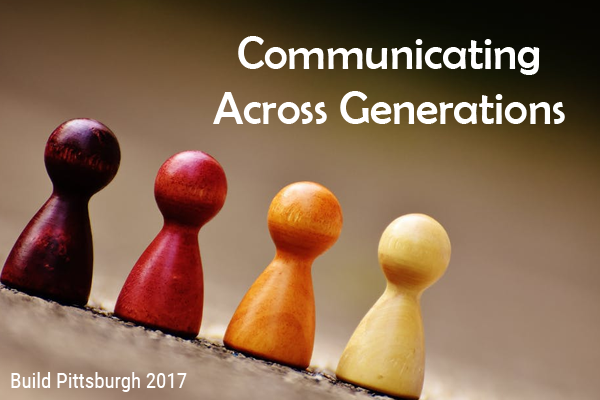While attending Build Pittsburgh 2017, which is an AIA event that brings together a variety of continuing education courses together. From the AIA Pittsburgh brochure, “Build Pittsburgh, now in its 16th year, brings together a community of architects and built industry professionals. Build Pittsburgh provides opportunities to interact, network, and connect with people representing all aspects of the built industry.”

I wanted to share the experience of attending a particular course, Communicating Across Generations led by Seth Hufford. It was not about sitting through a presentation of slides and occasional attendee interaction, but about getting everyone involved throughout the session. The course itself was about the generational type gaps that are currently moving through the working world. The Silent Generation mainly retired, Baby Boomers running the show, Generation X moving into leadership positions, and the Millennials joining the profession.
The important aspect is that the session was not about saying who was right or wrong about their values and beliefs, but identifying the similarities in thought throughout the generations. The first step in the class was to break out into groups based on their generation title.
Silent Generation (1925-1945)
Baby Boomers (1946-1964)
Generation X (1965-1979)
Millennials (1980-1995)
Within these groups we were tasked with identifying five values of each generation. Then presenting these values to the other groups. There was a total of four groups, two of which were Generation X to keep the groups roughly the same number of people. (Roughly 40 people attended the course) As the groups were placed into different areas of the group to collaborate on values we couldn’t help but notice a curious occurrence. The Baby Boomers were 100% male, the Generation X groups had a fair number of females, and the Millennials only had three males. It was enlightening to see the gender changes over the generations.
When going over the values the Baby Boomers generally stuck to the idea of paying your due’s and working to get where they are today. The Millennials identified their biggest value as flexibility. Flexibility at first seems like it would go against the baby boomer’s mentality, but in actuality it was about identifying that everyone works differently. It’s not about staying at work longer than your principals but working to find a balance between your personal interests, accomplishing the goals, and deadlines set by the firm. The two Generation X groups did identify similar top values even though they were in separate groups. They are the generation blending the values of the Baby Boomers and Millennials. For this group identifying the importance of the values of the Baby Boomers, but accepting and approving of the work life flexibility from the Millennials.
For the second half of the course we broke into mixed generation groups to create values as a group. Each group had to have multiple people from each generational group. As a course group as a whole these were the identified list of values.
Core Hours with Flexibility – identified the importance of flexibility from a standpoint that everyone works different, but also important to have the office working together. Collaboration, hearing conversations, being available for questions,
Ownership to projects/tasks – An important value no matter your generation, is taking ownership of a project and the tasks one is given. The signifies an amount of responsibility to everyone.
Technology/Training – The generations teach each other. There are new technologies and programs students are learning in school; combining with the experience and lessons learned from other generations.
Expectations
Responsibility
Ownership
Setting
COMMUNICATION – Technology is constantly changing and with new ways of communicating available. How can your staff better communicate with each other? There was also an acknowledgment that clients can be from a variety of generations. It is about a combination of steps to know the different ways how to communicate to your staff as well as present and future clients.
Values of Approach – There is value in approaching design problems in different ways. Whether that is in different mediums or programs, but identifying that everyone has their own unique process on approaching a project.
Intentional Interactions – In the architectural profession it is important to socialize and not just within your own generation. The profession as a whole needs to make strides to break down those generational conversation groups that form at social events.
Last but not least, MENTORSHIP. – Make time for it. The growth of the profession is very much about the mentorship and learning from others. This goes both ways and it’s something that needs to occur and there is value in making time for it within busy schedules.
An important takeaway from this course was that everyone may have come in identifying there are differences within the group as a whole between everyone but it is more important to get a handle on the similarities. Having these mixed-generational group conversations, helps to show that the perceived generational gaps are not has severe as one may have initially thought. It’s about taking the time to identify the similarities on a personal and professional level to strengthen the profession, learn from each other, and be able to identify with everyone within the profession.
Written by Katelyn Rossier

